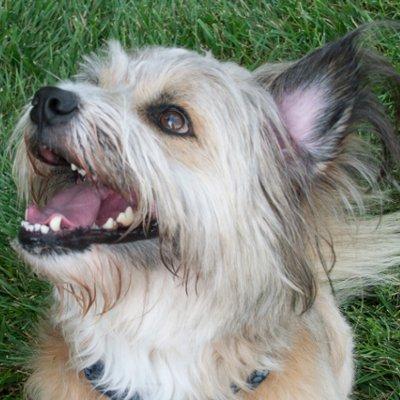By Roslyn McKenna, PetSafe Web Content Specialist 
With a face like this, who wouldn't cast Doc to star in their commercials?
My dog Doc was recently chosen to be the star of several PetSafe videos. He’s a well-rounded dog with looks, charm, and personality, but his best quality for the silver screen is his intelligence. He’s a smart dog who already knows basic commands and learns new ones quickly, so it didn’t take much to get him ready for his new acting career. After a few weeks of training for at least 10 minutes a day, he was ready to be a star!
Here’s how I trained him, with the help of dog trainer Mike Shafer at the PetSafe Village.
Clicker Shaping Exercises
Doc already knows sit, stay, and come, but he needed to learn a few new tricks for the video. It’s easy to train a dog who already somewhat knows a command, but how do you teach a dog a new trick he’s never done before? It’s actually quite simple: you try to get your dog to do the behavior, and if he doesn’t, you work up to it.
When I was clicker training my cat Lily, she already rolled over when I stood over her for long enough. By clicking and treating each time she rolled over, then adding the words “Roll Over,” eventually I got her to do it on command. With Doc, I needed to teach him to drink on command for the video. I waited until he was thirsty after a long walk, brought him over to our pet fountain, and gave him a click + treat each time he took a drink. Then I added the "Drink" command and worked up to getting him to drink when he wasn’t thirsty. This is called shaping; you’re changing your pet’s behavior by marking when they do something you like.
Since behavior that is rewarded gets repeated, you use the click to mark the right behavior and add a treat to make sure they’ll do it again. Shaping takes a lot of patience. You have to wait until your pet does what you want, and with each successive correct behavior, you have to slowly increase your standards.
When we started training, first I clicked and gave a treat every time Doc looked at the fountain. You have to be very precise and click the exact moment he looks at it. Eventually, he figured out he was getting a treat when he looked at it. When he looked at it over and over, I stopped giving him treats just for looking at it and started only clicking and treating for walking up to it. Then I only clicked and treated when he took a drink. And then I gave a click and treat when he took 2 drinks, then 3 drinks, and so on.
The Learning Process
There’s a process for learning, and it’s kind of cool to see your pet learning at each step. Your dog will try to figure out how to get the treat. Then he’ll try to figure out how much he needs to do to get the treat. You’ll see your pet’s confidence grow as he starts to get it. Then they’ll try to figure out the minimum amount of effort needed to get the reward. Don’t reward them for an incomplete action, unless they’re still learning it.
Each training session should last 10-30 minutes, depending on the pet. Shorter, more frequent sessions are better. Stop a session when your pet stops progressing. When you come back to train, expect to start with slightly lower standards than the last session. If we ended with Doc taking 2 drinks from the fountain in the last session, I might start by clicking and treating when he put his nose in the bowl. I wouldn’t expect him to start taking 2 drinks right away; it takes pets a little time to remember what they learned from last time, so this is kind of like a review session.
Adding the Command
Once Doc was going to the fountain and drinking, I started saying “Drink” as he was drinking. This was distracting for him at first, so I tried just speaking out loud before he started to drink to get him used to hearing my voice. Then I said the word “Drink” as he was drinking. Eventually I started saying it right before he started to drink. He would walk up to the bowl, I would say “Drink,” he would start drinking, then after a certain number of drinks I would click and treat, then say Drink again, and we would repeat this several times.
The last thing is to practice with distractions. This is the hardest part, because pets get distracted easily. On the day of the video shoot, it was difficult to get Doc to drink for more than a second or two. (With a whole camera crew of people to say hi to, who can blame him?) So after many shots of very little drinking, I took him for a long walk to tire him out and brought him back inside—resulting in a perfect take! Sometimes you can train all day, but just playing to your pet’s natural behaviors gets better results on camera.
While our clicker practice didn’t help us out on the day of the shoot, it was fun to teach Doc a new trick, and it was a great bonding experience for us. Teaching your dog something new raises his confidence and also raises your status in his eyes as he learns that listening to you can be rewarding.
What tricks have you taught your pet? Tell us below in the comments!
ABOUT ROSLYN At PetSafe’s Knoxville headquarters, Roslyn Ayers is the Web Content Specialist. Roslyn comes from a family of animal lovers and has a B.A. in Writing/Communications from Maryville College. She has volunteered with various animal rescues in Tennessee and South Carolina. Roslyn currently shares her home with four cats and her dog, Doc.



